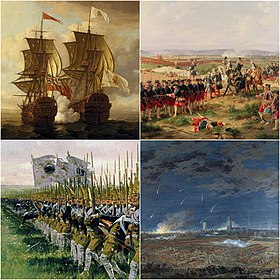
Back Oostenrykse Erfenisoorlog AF حرب الخلافة النمساوية Arabic Guerra de Socesión Austriaca AST Avstriya irsi uğrunda müharibə AZ اوتریش ورارث ساواشی AZB Война за австрийското наследство Bulgarian Brezel Hêrezh Aostria BR Rat za austrijsko naslijeđe BS Guerra de Successió Austríaca Catalan Války o rakouské dědictví Czech
| War of the Austrian Succession | |||||||||
|---|---|---|---|---|---|---|---|---|---|
| Part of the French–Habsburg rivalry and the Austria–Prussia rivalry | |||||||||
 Left to right:
| |||||||||
| |||||||||
| Belligerents | |||||||||
| |||||||||
| Commanders and leaders | |||||||||
| Strength | |||||||||
|
1740: 1742: |
1747: 1742: | ||||||||
| Casualties and losses | |||||||||
|
France: 158,400 killed and wounded[7][c] Prussia: 23,100 killed and wounded[7] Spain: 3,000 killed and wounded[7][d] |
Habsburg monarchy: 148,000 killed and wounded[7] Great Britain: 26,400 killed and wounded[7] [e] Dutch Republic: 14,630 killed and wounded[7] Savoy-Sardinia: 7,840 killed and wounded[7] | ||||||||
| Total 750,000 dead or wounded[8] | |||||||||
The War of the Austrian Succession[f] was a European conflict fought between 1740 and 1748, primarily in Central Europe, the Austrian Netherlands, Italy, the Atlantic Ocean and Mediterranean Sea. Related conflicts include King George's War in North America, the War of Jenkins' Ear, the First Carnatic War, and the First and Second Silesian Wars.
Its pretext was the right of Maria Theresa to succeed her father, Emperor Charles VI, as ruler of the Habsburg monarchy. France, Prussia, and Bavaria saw it as an opportunity to challenge Habsburg power, while Maria Theresa was backed by Britain, the Dutch Republic, and Hanover, collectively known as the Pragmatic Allies. As the conflict widened, it drew in other participants, among them Spain, Sardinia, Saxony, Sweden, and Russia.
Prussia occupied the Austrian province of Silesia in 1740, although Austria and Sardinia defeated Spanish attacks in Northern Italy. By early 1748, France held most of the Austrian Netherlands, but was close to bankruptcy due to the cost of the war and a crippling British naval blockade. The stalemate led to the Treaty of Aix-la-Chapelle which confirmed Maria Theresa in her titles but failed to resolve underlying tensions between the signatories, many of whom were unhappy with the terms. France achieved minimal gains for vast expenditure, while the Spanish gained the Duchies of Parma, Piacenza and Guastalla.
Prussia, often considered the clearest winner, acquired Silesia from Austria, an outcome that undermined the long-standing Anglo-Austrian Alliance, since Maria Theresa deeply resented Britain's insistence she cede Silesia to make peace and made it her main objective to regain it. At the same time, the war demonstrated that Hanover, then held in personal union with the British Crown, was vulnerable to Prussian attacks, while many British politicians felt they received little benefit from the enormous subsidies paid to Austria. The result was the realignment known as the Diplomatic Revolution. Austria and France ended the rivalry which had dominated European affairs for centuries, while Prussia allied with Great Britain. These changes set the scene for the outbreak of the Seven Years' War in 1756.
- ^ a b c d e Van Nimwegen 2002, p. 403.
- ^ a b c d Clodfelter 2017, p. 78.
- ^ Dwyer 2001, p. 14.
- ^ Van Nimwegen 2002, p. 102.
- ^ Van Nimwegen 2002, p. 12 & 103.
- ^ Hanlon 1997, p. 120.
- ^ a b c d e f g Statistics of Wars, Oppressions and Atrocities of the Eighteenth Century
- ^ Clodfelter 2017, p. 81.
Cite error: There are <ref group=lower-alpha> tags or {{efn}} templates on this page, but the references will not show without a {{reflist|group=lower-alpha}} template or {{notelist}} template (see the help page).